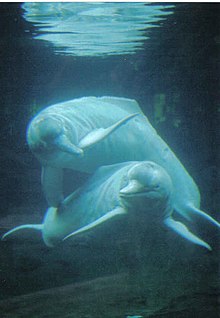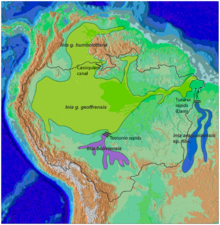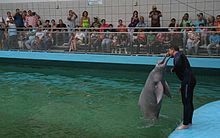Other common names of the species include boto, boto cor-de-rosa, boto vermelho, bouto, bufeo, tonina and pink dolphin.[1]

Description
The Amazon river dolphin is one of the river dolphins formerly included in the superfamily Platanistoidea, making it paraphyletic; it has since been moved to Inioidea. Although not a large cetacean in general terms, this dolphin is the largest freshwater cetacean; it can grow larger than a human. Body length can range from 1.53 to 2.4 m (5.0 to 7.9 ft), depending on subspecies. Females are typically larger than males.[citation needed] The largest female Amazon river dolphins can range up to 2.5 m (8.2 ft) in length and weigh 98.5 kg (217 lb). The largest male dolphins can range up to 2.0 m (6.6 ft) in length and weigh 94 kg (207 lb).[2][3]They have unfused neck vertebrae, enabling them to turn their heads 90 degrees. Their flexibility is important in navigating through the flooded forests. Also, they possess long beaks which contain 24 to 34 conical and molar-type teeth on each side of the jaws.[4]
In colour, these dolphins can be either light gray or carnation pink.
Taxonomy
The species was described by Henri Marie Ducrotay de Blainville in 1817. Rice's 1998 classification[5] lists a single species, Inia geoffrensis in the genus Inia, with three recognised subspecies. Some older classifications, as well as some recent publications,[6] listed the boliviensis population as a separate species. In 2012 the Society for Marine Mammalogy[7] began considering the Bolivian (Inia geoffrensis boliviensis) and Amazonian (Inia geoffrensis geoffrensis) subspecies as full species Inia boliviensis and Inia geoffrensis, respectively; however, much of the scientific community consider the boliviensis population to be a subspecies of Inia geoffrensis. The genus Inia separated from its sister taxon during the Miocene epoch.[8]The two currently recognized species are:
- I. g. geoffrensis — distributed in the Amazon and Araguaia/Tocantins basins (excluding the Madeira River drainage, upstream of the Teotonio Rapids in Rondônia)
- I. g. humboldtiana — distributed in the Orinoco basin
- I. boliviensis — distributed in the Bolivian sub-basin of the Amazon basin upstream of the Teotonio Rapids in Rondônia
Ecology
The Amazon river dolphin is found throughout the Amazon and Orinoco. It is particularly abundant in lowland rivers with extensive floodplains. During the annual rainy season, these rivers flood large areas of forests and marshes along their banks. The Amazon river dolphin specialises in hunting in these habitats, using its unusually flexible neck and spinal cord to maneuver among the underwater tree trunks, and using its long snout to extract prey fish from hiding places in hollow logs and thickets of submerged vegetation.When the water levels drop, the dolphins move either into the main river channels or into large lakes in the forest, and take advantage of the concentrated prey in these reduced water bodies. They feed on crustaceans, crabs, small turtles, catfish, piranha, shrimp, and other fish.[4]
Behavior
Adult males have been observed carrying objects in their mouths, objects such as branches or other floating vegetation, balls of hardened clay. The males appear to carry these objects as a socio-sexual display which is part of their mating system. The behaviour is "triggered by an unusually large number of adult males and/or adult females in a group, or perhaps it attracts such into the group. A plausible explanation of the results is that object carrying is aimed at females and is stimulated by the number of females in the group, while aggression is aimed at other adult males and is stimulated by object carrying in the group."[10]The male reaches sexual maturity at about 2 metres (6.6 ft) and the female at about 1.7 metres (5.6 ft). Most calves are born between July and September after a gestation period of 9 to 12 months; they are about 0.81 metres (2.7 ft) long at birth and weigh about 6.8 kilograms (15 lb).[4] The young follow their parents closely for a few months, and often two adults are seen swimming with two or more small juveniles.
Human interaction
 The region of the Amazon in Brazil has an extension of 5 million km2 containing diverse fundamental ecosystems.[13][14] One of these ecosystems is a floodplain, or a várzea forest, and is home to a large number of fish species which are an essential resource for human consumption.[15] The várzea is also a major source of income through excessive local commercialized fishing.[13][16][17] Várzea consist of muddy river waters containing a vast number and diversity of nutrient rich species.[10] The abundance of distinct fish species is what lures in the Amazon River dolphin into the várzea areas of high water occurrences during the seasonal flooding.[18]
The region of the Amazon in Brazil has an extension of 5 million km2 containing diverse fundamental ecosystems.[13][14] One of these ecosystems is a floodplain, or a várzea forest, and is home to a large number of fish species which are an essential resource for human consumption.[15] The várzea is also a major source of income through excessive local commercialized fishing.[13][16][17] Várzea consist of muddy river waters containing a vast number and diversity of nutrient rich species.[10] The abundance of distinct fish species is what lures in the Amazon River dolphin into the várzea areas of high water occurrences during the seasonal flooding.[18]In addition to attracting predators such as the Amazon River dolphin, these high water occurrences are an ideal location to draw in the local fisheries. Human fishing activities directly compete with the Amazon River dolphins for the same fish species, the tambaqui (Colossoma macropomum) and the Pirapatinga (Piaractus brachypomus), resulting in deliberate or unintentional catches of the Amazon River dolphin.[19][20][21][13][22][23][24][25] The local fishermen overfish and when the Amazon River dolphins remove the commercialized fish from the nets and lines, it causes damages to the equipment and the capture, as well as a negative reaction from the local fishermen.[21] [23][24] The negative reactions of the local fishermen is also attributed to the Brazilian Institute of Environment and Renewable Natural Resources prohibiting from killing the Amazon River dolphin, yet not compensating the fishermen for the damage done to their equipment and capture.[25]
During the process of catching the commercialized fish, the Amazon River dolphins will get caught in the nets and exhaust themselves until they die, or the local fishermen will deliberately kill the Amazon River dolphins that become entangled in their nets.[15] The carcasses of the Amazon River dolphins are disposed of, consumed, or used as bait to attract a scavenger catfish, the piracatinga (Calophysus macropterus).[15][26] The usage of the Amazon River dolphin carcass as bait for the piracatinga dates back from 2000.[26] The increasing consumption demand by the local inhabitants and Colombia for the piracatinga, has created a market for distribution of the Amazon River dolphin carcasses to be used as bait throughout these regions.[25]
Of the 15 Amazon River dolphins that were found in the Japurá River, 73% of the carcasses were killed for bait, disposed of, or abandoned in entangled gillnets.[15] It is important to note that the data does not fully represent the actual overall number of deaths of the Amazon River dolphins, whether accidental or intentional, because a variety of factors make it extremely complicated to record and medically examine all the carcasses.[15][20][23] Scavenger species feed upon the carcasses and the complexity of the river currents make it nearly impossible to locate all the carcasses.[15] More importantly, the local fishermen do not report these deaths out of fear that a legal course of action will be taken against them,[15] as the Amazon River dolphin and other cetaceans are protected under the Brazilian Federal Law prohibiting any takes, harassments, and kills of the species.[27]
In popular culture

In traditional Amazon River folklore, at night, an Amazon river dolphin becomes a handsome young man who seduces girls, impregnates them, and then returns to the river in the morning to become a dolphin again. This dolphin shapeshifter is called an encantado. It has been suggested that the myth arose partly because dolphin genitalia bear a resemblance to those of humans. Others believe the myth served (and still serves) as a way of hiding the incestuous relations which are quite common in some small, isolated communities along the river.[28] In the area, there are tales that it is bad luck to kill a dolphin. Legend also states that if a person makes eye contact with an Amazon river dolphin, he or she will have lifelong nightmares. Local legends also state that the dolphin is the guardian of the Amazonian manatee, and that, should one wish to find a manatee, one must first make peace with the dolphin.
Associated with these legends is the use of various fetishes, such as dried eyeballs and genitalia.[28] These may or may not be accompanied by the intervention of a shaman. A recent study has shown, despite the claim of the seller and the belief of the buyers, none of these fetishes are derived from the boto. They are derived from Sotalia guianensis, are most likely harvested along the coast and the Amazon River delta, and then are traded up the Amazon River. In inland cities far from the coast, many, if not most, of the fetishes are derived from domestic animals such as sheep and pigs.[29]

No comments:
Post a Comment
Note: Only a member of this blog may post a comment.